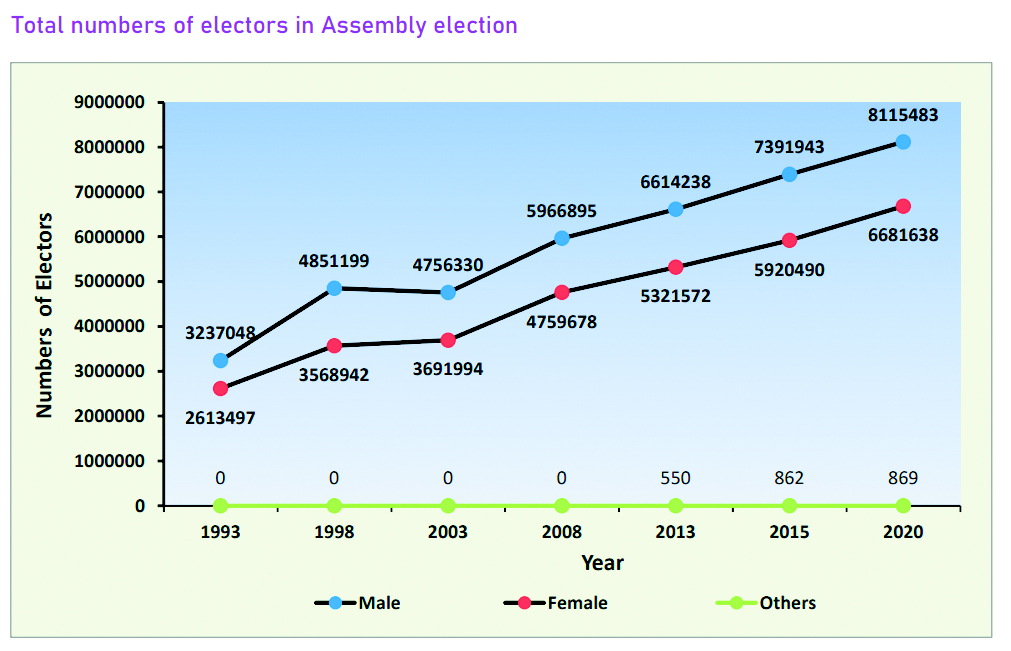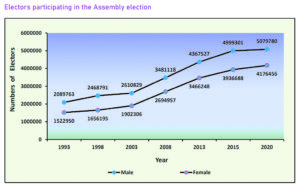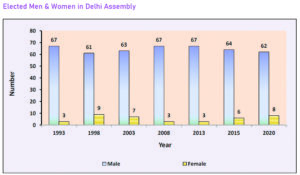
Women empowerment refers to the process of enabling women to have equal opportunities, rights, and access to resources, education, and decision-making. It aims to promote gender equality and eliminate discrimination against women, fostering their independence and self-determination. Efforts towards women’s empowerment encompass various aspects, including economic, social, political, and cultural empowerment.

It’s a critical goal for achieving a more equitable and just society. An important aspect of the empowerment of women is the extent of their involvement in the process of decision making whether in the household or the government. In this analysis, the statistics regarding the participation of women in Assembly & Lok Sabha Elections, Courts and Police Departments have been presented.

Numbers of Electors/ Voters/Percentage of electors participation in the election
As per the data of the Election Commission of India, the total number of electors in Delhi was 14797990 consisting of 8115483 males, 6681638 females and 869 electors who were transgender during the General Election to the Legislative Assembly of NCT of Delhi 2020.
Out of these electors, 5079780 were male voters, 4176456 were female voters, 340 were transgender voters and 39217 were service voters. The percentage of women electors participating in the election during the fifth Assembly Election 1993 was 58.27% while it has gone up to 62.51% in the Eleventh Assembly Election 2020.
Women’s participation in Delhi Assembly Elections
The participation of women in the Delhi Assembly elections has been documented over the years, revealing interesting trends. Looking back to 1993, the data showcases the number of elected representatives, distinguishing between male and female members, and providing a total count of seats.
In 1998, there was a notable surge in female representation, with 9 out of 70 seats occupied by women. The subsequent years witnessed variations in the numbers, maintaining a balance between male and female elected members. The data, spanning from 1993 to 2020, reflects the dynamic nature of gender representation in Delhi’s political landscape, with fluctuations in the levels of women’s involvement in the assembly.
Numbers of MLAs
Out of the 70 seats in the Delhi Assembly Election, the number of elected men and women in the Delhi Assembly Election 2015 were 64 and 6 respectively while in the Assembly Election 2020 the numbers of men were 62 and the numbers of women were 8.
The participation of men had decreased and women’s participation had increased in Assembly Election 2020 as compared to 2015.
Numbers of Judges in Hon’ble Supreme Court & High Court of Delhi
As per the data of the Department of Justice, M/o Law & Justice, the approved Judge Strength in the Supreme Court was 34 consisting of 31 male and 3 female judges as of 01.06.2023 while out of 60 approved Judge strength in Delhi High Court, 38 were male and 10 were female judges during the same period.
Women empowerment refers to the process of enabling women to have equal opportunities, rights, and access to resources, education, and decision-making. It aims to promote gender equality and eliminate discrimination against women, fostering their independence and self-determination. Efforts towards women’s empowerment encompass various aspects, including economic, social, political, and cultural empowerment.
It’s a critical goal for achieving a more equitable and just society. An important aspect of the empowerment of women is the extent of their involvement in the process of decision making whether in the household or the government. In this analysis, the statistics regarding the participation of women in Assembly & Lok Sabha Elections, Courts and Police Departments have been presented.
Numbers of Electors/ Voters/Percentage of electors participation in the election
As per the data of the Election Commission of India, the total number of electors in Delhi was 14797990 consisting of 8115483 males, 6681638 females and 869 electors who were transgender during the General Election to the Legislative Assembly of NCT of Delhi 2020.
Out of these electors, 5079780 were male voters, 4176456 were female voters, 340 were transgender voters and 39217 were service voters. The percentage of women electors participating in the election during the fifth Assembly Election 1993 was 58.27% while it has gone up to 62.51% in the Eleventh Assembly Election 2020.
Women’s participation in Delhi Assembly Elections
The participation of women in the Delhi Assembly elections has been documented over the years, revealing interesting trends. Looking back to 1993, the data showcases the number of elected representatives, distinguishing between male and female members, and providing a total count of seats.
In 1998, there was a notable surge in female representation, with 9 out of 70 seats occupied by women. The subsequent years witnessed variations in the numbers, maintaining a balance between male and female elected members. The data, spanning from 1993 to 2020, reflects the dynamic nature of gender representation in Delhi’s political landscape, with fluctuations in the levels of women’s involvement in the assembly.
Numbers of MLAs
Out of the 70 seats in the Delhi Assembly Election, the number of elected men and women in the Delhi Assembly Election 2015 were 64 and 6 respectively while in the Assembly Election 2020 the numbers of men were 62 and the numbers of women were 8.
The participation of men had decreased and women’s participation had increased in Assembly Election 2020 as compared to 2015.
Numbers of Judges in Hon’ble Supreme Court & High Court of Delhi
As per the data of the Department of Justice, M/o Law & Justice, the approved Judge Strength in the Supreme Court was 34 consisting of 31 male and 3 female judges as of 01.06.2023 while out of 60 approved Judge strength in Delhi High Court, 38 were male and 10 were female judges during the same period.
Police strength in Delhi
As per the data of the Bureau of Police Research and Development as of 01.01.2021 out of the total 90523 police strength in Delhi, the female police strength was 10720 consisting of 9584 women in Civil Police and 554 Women in Special Armed Police Battalion, 248 women in Traffic Police, 143 women in Special Operations Group Unit, 96 were in Crime Investigation Deptt and 95 were in Special Branch dealing with intelligence.
In conclusion, the comprehensive examination of women’s participation and representation across various sectors in Delhi reveals both progress and areas for improvement. Efforts towards women’s empowerment have seen positive shifts in political involvement, with increasing percentages of women electors participating in elections over the years.
The fluctuations in the number of elected women representatives in the Delhi Assembly reflect the dynamic nature of gender representation in politics. While there has been an encouraging rise in the number of women MLAs in the 2020 Assembly Election compared to 2015, further strides are necessary. In the judiciary and law enforcement, the presence of women judges and police officers in Delhi has shown positive signs, highlighting the ongoing commitment to inclusivity.
Nevertheless, there is room for continued efforts to enhance gender diversity in these critical institutions. Overall, the data underscores the significance of sustained endeavours for women’s empowerment across sectors to achieve true gender equality in the capital city.
As per the data of the Bureau of Police Research and Development as of 01.01.2021 out of the total 90523 police strength in Delhi, the female police strength was 10720 consisting of 9584 women in Civil Police and 554 Women in Special Armed Police Battalion, 248 women in Traffic Police, 143 women in Special Operations Group Unit, 96 were in Crime Investigation Deptt and 95 were in Special Branch dealing with intelligence.
In conclusion, the comprehensive examination of women’s participation and representation across various sectors in Delhi reveals both progress and areas for improvement. Efforts towards women’s empowerment have seen positive shifts in political involvement, with increasing percentages of women electors participating in elections over the years.
The fluctuations in the number of elected women representatives in the Delhi Assembly reflect the dynamic nature of gender representation in politics. While there has been an encouraging rise in the number of women MLAs in the 2020 Assembly Election compared to 2015, further strides are necessary. In the judiciary and law enforcement, the presence of women judges and police officers in Delhi has shown positive signs, highlighting the ongoing commitment to inclusivity.
Nevertheless, there is room for continued efforts to enhance gender diversity in these critical institutions. Overall, the data underscores the significance of sustained endeavours for women’s empowerment across sectors to achieve true gender equality in the capital city.